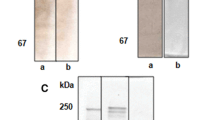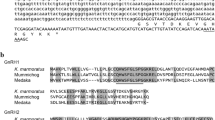Abstract
The existence of an egg-laying hormone (ELH) was identified for the first time in the black tiger shrimp, Penaeus monodon, by means of immunoenzyme and immunofluorescence techniques. This was achieved using a polyclonal antibody produced against expressed recombinant ELH of the female Australian blacklip abalone, Haliotis rubra. The shrimp ELH reactive material was found to be localised within female neurosecretory tissues and the secretory tissue of the antennal gland, but was not identified in the X-organ sinus gland within the eyestalk. It was also present in the ovary, where the amount of ELH present was observed to be greatest in the period prior to spawning. These findings implied that the induction of P. monodon spawning might be involved with humoral regulation relating to ELH expression.




Similar content being viewed by others
References
Arena L, Montalvan M, Espinosa G, Gaxiola G, Sanchez A, Wormhoudt AV, Hernandez D, Diaz T, Rosa C (2003) Genetic relationship between Litopenaeus setiferus (L.) and L. schmitti (Burkenroad) determined by using 16S mitochondrial sequences and enzymatic analysis. Aquac Res 34:981–990
Boonyaratpalin M, Supamattaya K, Verakunpiriya V, Suprasert D (2001) Effects of aflatoxin B1 on growth performance, blood components, immune function and histopathological changes in black tiger shrimp (Penaeus monodon Fabricius). Aquac Res 32:388
Bray WA, Lawrence AL (1998) Successful reproduction of Penaeus monodon following hypersaline culture. Aquaculture 159:275–282
Chanpoo M, Apisawetakan S, Thongkukiatkul A, Wanichanon C, Linthong V, Kruatrachue M, Upatham ES, Pumthong T, Hanna PJ, Sobhon P (2001) Localization of egg-laying hormone in the gonads of a tropical abalone, Haliotis asinina Linnaeus. J Shellfish Res 20:725–731
Claeys I, Simonet G, Van Loy T, De Loof A, Vanden Broeck J (2003) cDNA cloning and transcript distribution of two novel members of the neuroparsin family in the desert locust, Schistocerca gregaria. Insect Mol Biol 12:473–481
Cummins S, Thongkukiatkul A, Hanna PJ (2001) Location of egg-laying hormone in reproductive structures and neurons of Haliotis rubra (Leach) using antibodies raised against recombinant fusion proteins. J Shellfish Res 20:705–710
Dall W (1957) A revision of the Australian species of Penaeinae (Crustacea: Decapoda: Penaeidae). Aust J Mar Fresh Res 1:136–230
Herndon L, Wolfner M (1995) A Drosophila seminal fluid protein, Acp26Aa, stimulates egg laying in females for 1 day after mating. Proc Natl Acad Sci USA 92:10114–10118
Hoang T, Lee ST, Keenan CP, Marsden GE (2002) Observations on growth, sexual maturity and spawning performance of pond-reared Penaeus merguiensis. Aquac Res 33:863
Jones DS, Morgan GJ (1994) A field guide to crustaceans of Australian waters. Reed, Chatswood
Keller R (1992) Crustacean neuropeptides: structures, functions and comparative aspects. Experientia 48:439–449
Klinbunga S, Penman DJ, McAndrew BJ, Tassanakajon A (1999) Mitochondrial DNA diversity in three populations of giant tiger shrimp Penaeus monodon. Mar Biotechnol 1:113–121
Kupferman I (1967) Stimulation of egg laying: possible neuroendocrine function of bag cells of abdominal ganglion of Aplysia californica. Nature 216:814–815
Lin SC, Liou CH, Cheng JH (2000) The role of the antennal glands in ion and body volume regulation of cannulated Penaeus monodon reared in various salinity conditions. Comp Biochem Physiol 127:121–129
Nanthika P, Paisarn S, Parin C, Siwaporn L, Weerawan S, Amorn P (2005) Production of monoclonal antibodies specific to eyestalk neuropeptides of Penaeus monodon using sinus gland section and immunosuppression technique. Sci Asia 31:29–35
Primavera JH (1978) Induced mauration and spawning in five-month-old Penaeus monodon Fabricius by eyestalk ablation. Aquaculture 13:355–359
Ram JL, Gallardo CS, Ram ML, Croll RP (1998) Reproduction-associated immunoreactive peptides in the nervous systems of prosobranch gastroods. Bio Bull 195:308–318
Saitongdee P, Apisawetakan S, Anunruang N, Poomthong T, Hanna JP, Sobhon P (2005) Egg-laying-hormone immunoreactivity in the neural ganglia and ovary of Haliotis asinina Linnaeus. Invert Neurosci 5:165–172
Salzet M, Verger-Bocquet M, Vanderbulcke F, Van Minnen J (1997) Leech egg-laying-like hormone: structure, neuronal distribution and phylogeny. Mol Brain Res 49:211–221
Scheller RH, Jackson JF, McAllister LB, Schwarts JH, Kandel ER, Axel R (1982) A family of genes that codes for ELH, a neuropeptide eliciting a stereotyped pattern of behavior in Aplysia. Cell 28:707–710
Theunis W, Van Minnen J, De Loof A (1990) Immunocytochemical localization in the central nervous system of four different insect species of molecules immunoreactive against peptides present in the caudodorsal cells of Lymnaea stagnalis. Gen Comp Endocrinol 79:415–422
Van Minnen J, Schallin HDFH, Ramkema MD (1992) Identification of putative egg-laying hormone containing neuronal systems in gastropod molluscs. Gen Comp Endocrinol 86:96–102
Vreugdenhil E, Jackson JF, Bouwmeester T, Smit AB, Van Minnen J, Van Heerikhuizen H, Klootwijk J, Joosse H (1988) Isolation, characterization, and evolutionary aspects of a cDNA clone encoding multiple neuropeptides involved in the stereotyped egg-laying behavior of the fresh water snail Lymnaea stagnalis. J Neurosci 8:4184–4191
Yahata T (1973) Induced spawning of abalone (Nordotis discus REEVE) injected with ganglional suspensions. Bull Jpn Soc Sci Fish 39:1117–1122
Acknowledgements
We wish to thank Nigel Preston and Melony Sellar, CSIRO Marine Laboratory, for supplying specimen of live shrimp. The assistance provided by Apichart Nernsoungnern was most appreciated. We thank the Thailand Research Fund and National Center for Genetic Engineering and Biotechnology of Thailand for providing financial support.
Author information
Authors and Affiliations
Corresponding author
Rights and permissions
About this article
Cite this article
Liu, Z., Sobhon, P., Withyachumnarnkul, B. et al. Identification of a putative egg-laying hormone in neural and ovarian tissues of the black tiger shrimp, Penaeus monodon, using immunocytochemistry. Invert Neurosci 6, 41–46 (2006). https://doi.org/10.1007/s10158-006-0016-0
Received:
Accepted:
Published:
Issue Date:
DOI: https://doi.org/10.1007/s10158-006-0016-0




